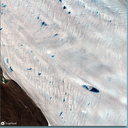Greenland ice melt, the largest part of sea level rise, kicks into high gear

The Greenland Ice Sheet saw a sharp spike in the rate and extent of melting last week, with 18 billion tons of water running into the North Atlantic in just three days. Satellite photos reveal melt ponds dotting the ice cover, particularly near the coasts.
Why it matters: Greenland's melting ice is the top annual contributor to global sea level rise. How much of and how quickly the ice sheet is lost will determine the fate of coastal cities from Hong Kong to Miami.
Driving the news: An uptick in ice loss that occurred during the July 15-17 period sent enough water careening off the ice sheet to fill 2.4 million Olympic-sized swimming pools, said Ted Scambos, a climate scientist at the University of Colorado at Boulder, in an interview.
- Put another way, it was the equivalent of covering all of West Virginia in four inches of water per day, for a total of 1 foot.
- While this sounds extreme, Scambos said it doesn't rank as the highest melt surge scientists have witnessed in recent years. Periods of exceptionally mild weather, even at the highest reaches of the ice sheet, have become common since about the year 2010, which some researchers find unnerving.
Context: "Since 2010, especially 2012, there have been lots of very extensive melt events," Scambos said, noting that northern Greenland, which was involved in the most recent event, has been seeing increasing intrusions of milder air and higher melt rates.
- "This was a widespread event," he said. "Overall, it continues to indicate that Greenland is trending towards more melting than was the case in the 1980s and 1990s."
- Scambos tied the most recent event to an unusually mild air mass that moved across the ice sheet from northern Canada, and not Europe's scorching heat wave. During it, the temperature reached 34°F (1.1°C) at a high-altitude weather station on the ice sheet, which is unusual for that location.
The intrigue: Other researchers told Axios that the extent of the melting seen in northern Greenland recently has been particularly noteworthy.
- William Colgan of the Geological Survey of Denmark and Greenland said in an email that temperatures got warm enough for snow to melt at a high elevation scientific ice core drilling site known as East GRIP, preventing re-supply flights from landing there due to the softness of the snow and ice.
- Mottram said the increased involvement of northern Greenland in these melt spikes may be due to changes in cloud cover there, Ruth Mottram, a climate scientist at the Danish Meteorological Institute, told Axios in an email.
What's next: Studies show that how much greenhouse gases we add to the air through the burning of fossil fuels, such as coal, oil and natural gas will largely determine the amount of ice loss from Greenland, and the potentially even greater ice melt from Antarctica, during the coming decades to centuries.
- The greater the emissions, the more vulnerable the ice sheets will become.
- We're already in a new reality at the poles, scientists told Axios.
The bottom line: Greenland has been losing ice mainly from ice flowing faster into the sea, and increased calving from ocean-terminating glaciers.
- "The ice sheet has lost more ice than it has gained every year except one (2016-17) since at least 2000," she said.
- On average, Mottram said, Greenland loses about 250 billion tons of ice per year.
- "A consistent loss of ice year after year is unfortunately the new normal in Greenland and the question that we scientists now ask ourselves is: How much will Greenland lose this year, not will Greenland net lose or gain ice this year?"